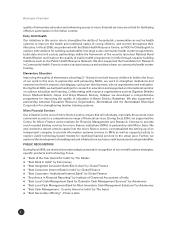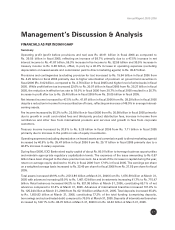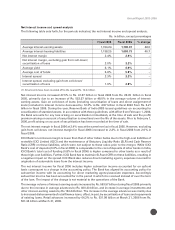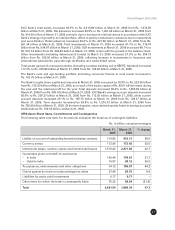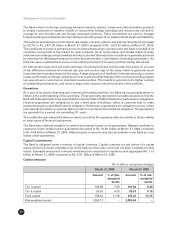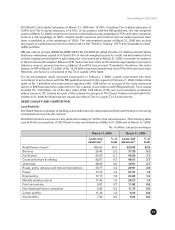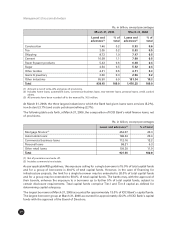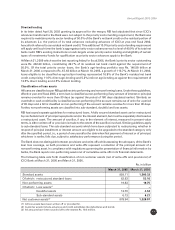ICICI Bank 2006 Annual Report Download - page 49
Download and view the complete annual report
Please find page 49 of the 2006 ICICI Bank annual report below. You can navigate through the pages in the report by either clicking on the pages listed below, or by using the keyword search tool below to find specific information within the annual report.
48
Management’s Discussion & Analysis
The Bank enters into foreign exchange forward contracts, options, swaps and other derivative products
to enable customers to transfer, modify or reduce their foreign exchange and interest rate risk and to
manage its own interest rate and foreign exchange positions. These instruments are used to manage
foreign exchange and interest rate risk relating to specific groups of on-balance sheet assets and liabilities.
The notional principal amount of interest rate swaps, currency options and interest rate futures increased
by 62.7% to Rs. 2,471.92 billion at March 31, 2006 compared to Rs. 1,519.22 billion at March 31, 2005.
This significant increase is primarily due to increased transactions carried out by the Bank on behalf of its
customers and growth in the market for such products. As an active player and market-maker in swap
and forward exchange contract markets and due to the fact that reduction in positions is generally achieved
by entering into offsetting transactions rather than termination / cancellation of existing transactions, the
bank has seen a substantial increase in the notional principal of its swap portfolio during this period.
An interest rate swap does not entail exchange of notional principal and the cash flow arises on account
of the difference between the interest rate pay and receive legs of the swap which is generally much
lower than the notional principal of the swap. A large proportion of the Bank’s interest rate swap, currency
swaps and forward exchange contracts are on account of market making which involves providing regular
two-way prices to customers or inter-bank counter parties. This results in generation of a higher number
of outstanding transactions, and hence a large value of gross notional principal of the portfolio.
Guarantees
As a part of its project financing and commercial banking activities, the Bank has issued guarantees to
enhance the credit standing of its customers. These generally represent irrevocable assurances that the
Bank will make payments in the event that the customer fails to fulfill its financial or performance obligations.
Financial guarantees are obligations to pay a third party beneficiary where a customer fails to make
payment towards a specified financial obligation. Performance guarantees are obligations to pay a third
party beneficiary where a customer fails to perform a non-financial contractual obligation. The guarantees
are generally for a period not exceeding 10years.
The credit risks associated with these products, as well as the operating risks, are similar to those relating
to other types of financial instruments.
The Bank has collateral available to reimburse potential losses on its guarantees. Margins available to
reimburse losses realized under guarantees amounted to Rs. 10.29billion at March 31, 2006 compared
to Rs. 4.06 billion at March 31, 2005. Other property or security may also be available to the Bank to cover
losses under guarantees.
Capital Commitments
The Bank is obligated under a number of capital contracts. Capital contracts are job orders of a capital
nature which have been committed. As of the balance sheet date, work had not been completed to this
extent. Estimated amounts of contracts remaining to be executed on capital account aggregated Rs. 1.13
billion at March 31, 2006 compared to Rs. 0.70billion at March 31, 2005.
Capital adequacy
Rs. in billion, except percentages
March 31, 2005 March 31, 2006
Amount % of risk- Amount % of risk-
weighted weighted
assets assets
Tier I capital 102.46 7.59 191.82 9.20
Tier II capital 56.57 4.19 86.61 4.15
Total capital 159.03 11.78 278.43 13.35
Risk-weighted assets 1,350.17 – 2,085.94 –




